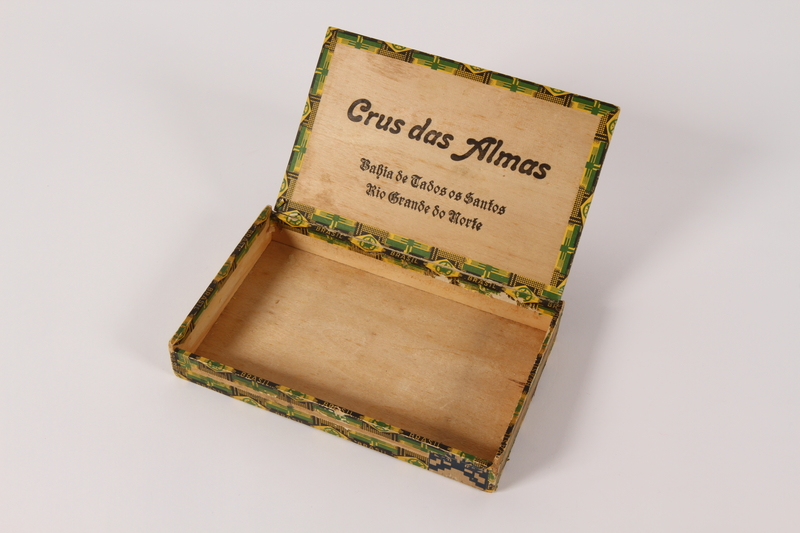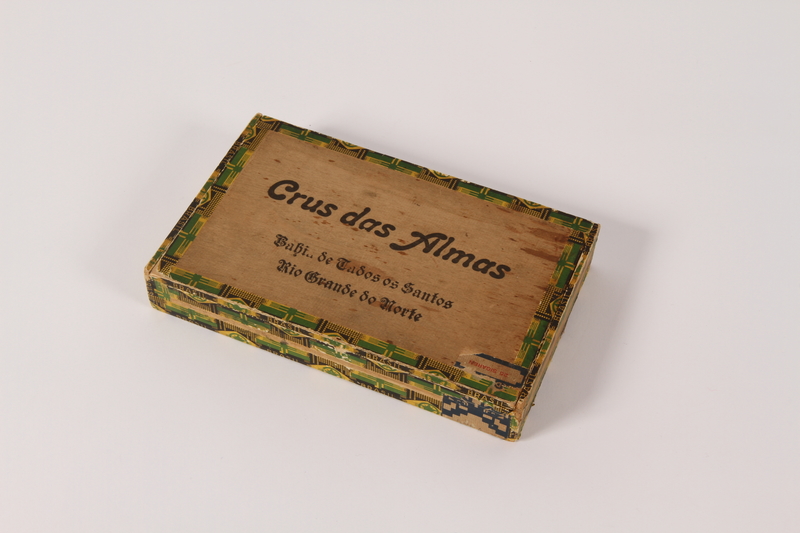Overview
- Brief Narrative
- Cigar box use to hold ration stamps that may have belonged to Abigail de Vries or her children. It is for a Brazilian cigar brand, but has a Dutch label on the bottom. Abigael was living in Amsterdam with her two children, 10 year old Hansje and 9 year old Ingeborg, when it was occupied by Germany in May 1940. The family was deported to Westerbork transit camp on May 26, 1943. In September, the children were released and sent to an orphanage in Amsterdam. Abigael was deported the next day to Bergen-Belsen concentration camp. On January 25, 1944, she was transferred to Theresienstadt which was liberated by Soviet troops on May 9, 1945. She was able to return to Amsterdam in July 1945. Her children were with her sisters who had taken custody of them from the orphanage in 1943. Hansje was paralyzed from the neck down, having been shot in the neck by a German soldier on April 23, 1945, while foraging for coal with his sister. Amsterdam had experienced severe food and fuel emergencies since the spring of 1945 so Abigael sent Inge to Copenhagen for several months to regain her health. Hansje died of his injuries on July 11, 1946.
- Credit Line
- United States Holocaust Memorial Museum Collection, Gift of Diana Nikkels
- Contributor
-
Subject:
Abigael de Vries
- Biography
-
Abigael de Vries was born on January 5, 1906, in Amsterdam, Netherlands. She had two children, Johannes (Hansje) Nolte, born on February 4, 1931, and Ingeborg, born in December 1931. Both children had the same father, a German, non-Jewish man whom Abigael met while living in Berlin, Germany. The relationship with the children's father did not work out and Abigael returned to Amsterdam. Germany occupied the Netherlands on May 10,1940. Hansje and Inge had to transfer to a Jewish school, as Jewish children were no longer allowed to attend Dutch public schools. On May 26, 1943, the family was deported to the Westerbork internment camp. Males and females were housed in separate barracks, but Abigael was determined that they should stay together and kept Hansje with them in the women's barracks. Food was scarce in the camp. Hansje decided to help with the distribution of food to get additional rations for his family. While serving one day, a big pot of boiling water spilled on his legs; he had to get medical attention, but he recovered. Inge and Hansje were able to attend an informal school. Inge witnessed other Jews getting deportation notices to concentration camps and saw the bodies of some who hanged themselves in the barrack washroom. On September 13, 1943, Inge, Hansje, and 19 other children, who were declared by the Germans as Mischlinge (born of one non-Jewish parent), were released from Westerbork and sent back to Amsterdam. Abigael was deported the next day to Bergen Belsen concentration camp. On January 25, 1944, she was transported to Theresienstadt which was liberated by the Russian Army on May 9, 1945.
The Americans sent her home to Amsterdam in July 1945. Abigael was placed in quarantine for several weeks in Eindhoven and then was reunited with her children. During her absence and after their release from Westerbork, Hansje and Inge had been placed in an orphanage in Amsterdam. Abigael's sisters, Rebecca and Heintje, who were married to non-Jewish Dutchmen, took the children into their homes: Hansje by Rebecca; Inge by Heintje. In the spring of 1945, food was desperately scarce in Holland. On April 23, 1945, while the children were out foraging for coal, a German soldier had shot Hansje in the neck; the fourteen years old boy was paralyzed from his neck down. Abigael sent Inge to Copenhagen, Denmark, for at least six months to regain her health, as Holland still did not have enough food. Hansje died of his wounds on July 11, 1946.
Physical Details
- Language
- Portuguese Dutch
- Classification
-
Containers
- Category
-
Boxes
- Object Type
-
Cigar boxes (lcsh)
- Physical Description
- Plywood cigar box with an attached lid with the Portuguese brand name stamped on the lid exterior and interior. The box rim is covered with green and yellow paper printer Brazil. The bottom of the box has a blue and white paper label with the word Nederland in white lettering.
- Dimensions
- overall: Height: 1.500 inches (3.81 cm) | Width: 8.625 inches (21.908 cm) | Depth: 5.250 inches (13.335 cm)
- Materials
- overall : plywood, paper, ink, adhesive
- Inscription
- lid, exterior and interior, stamped, black ink : Crus da Almas
Rights & Restrictions
- Conditions on Access
- No restrictions on access
Administrative Notes
- Legal Status
- Permanent Collection
- Provenance
- The cigar box was donated to the United States Holocaust Memorial Museum in 2009 by Diana Nikkels, the granddaughter of Abigael de Vries and the daughter of Ingeborg de Vries Nikkels.
- Record last modified:
- 2022-07-28 21:51:06
- This page:
- https://collections.ushmm.org/search/catalog/irn532741
Also in Abigael de Vries family collection
The collection consists of artifacts, documents, and photographs relating to the experiences of Abigael de Vries, Ingeborg de Vries Nikkels, Simon Berklou, and friends in the Netherlands during World War II.
Date: 1940-1947
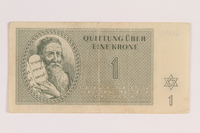
Theresienstadt ghetto-labor camp scrip, 1 krone note, issued to a Dutch Jewish inmate
Object
Scrip, valued at 1 krone, that may have been issued to Abigael de Vries in the Theresienstadt (Terezin) ghetto-labor camp in 1943. All currency was confiscated from deportees upon entry and replaced with scrip and ration coupons that could be exchanged only in the camp. Abigael was living in Amsterdam with her two children, 10 year old Hansje and 9 year old Ingeborg, when it was occupied by Germany in May 1940. The family was deported to Westerbork transit camp on May 26, 1943. In September, the children were released and sent to an orphanage in Amsterdam. Abigael was deported the next day to Bergen-Belsen concentration camp. On January 25, 1944, she was transferred to Theresienstadt and was there when the camp was liberated by Soviet troops on May 9, 1945. She was able to return to Amsterdam in July 1945. Her children were with her sisters who had taken custody of them from the orphanage in 1943. Hansje was paralyzed from the neck down, having been shot in the neck by a German soldier on April 23, 1945, while foraging for coal with his sister. Amsterdam had experienced severe food and fuel emergencies since the spring of 1945 so Abigael sent Inge to Copenhagen. Hansje died of his injuries on July 11, 1946.
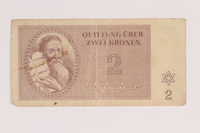
Theresienstadt ghetto-labor camp scrip, 2 kronen note, issued to a Dutch Jewish inmate
Object
Scrip, valued at 2 kronen, that may have been issued to Abigael de Vries in the Theresienstadt (Terezin) ghetto-labor camp in 1943. All currency was confiscated from deportees upon entry and replaced with scrip and ration coupons that could be exchanged only in the camp. Abigael was living in Amsterdam with her two children, 10 year old Hansje and 9 year old Ingeborg, when it was occupied by Germany in May 1940. The family was deported to Westerbork transit camp on May 26, 1943. In September, the children were released and sent to an orphanage in Amsterdam. Abigael was deported the next day to Bergen-Belsen concentration camp. On January 25, 1944, she was transferred to Theresienstadt and was there when the camp was liberated by Soviet troops on May 9, 1945. She was able to return to Amsterdam in July 1945. Her children were with her sisters who had taken custody of them from the orphanage in 1943. Hansje was paralyzed from the neck down, having been shot in the neck by a German soldier on April 23, 1945, while foraging for coal with his sister. Amsterdam had experienced severe food and fuel emergencies since the spring of 1945 so Abigael sent Inge to Copenhagen. Hansje died of his injuries on July 11, 1946.
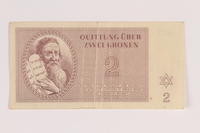
Theresienstadt ghetto-labor camp scrip, 2 kronen note, issued to a Dutch Jewish inmate
Object
Scrip, valued at 2 kronen, that may have been issued to Abigael de Vries in the Theresienstadt (Terezin) ghetto-labor camp in 1943. All currency was confiscated from deportees upon entry and replaced with scrip and ration coupons that could be exchanged only in the camp. Abigael was living in Amsterdam with her two children, 10 year old Hansje and 9 year old Ingeborg, when it was occupied by Germany in May 1940. The family was deported to Westerbork transit camp on May 26, 1943. In September, the children were released and sent to an orphanage in Amsterdam. Abigael was deported the next day to Bergen-Belsen concentration camp. On January 25, 1944, she was transferred to Theresienstadt and was there when the camp was liberated by Soviet troops on May 9, 1945. She was able to return to Amsterdam in July 1945. Her children were with her sisters who had taken custody of them from the orphanage in 1943. Hansje was paralyzed from the neck down, having been shot in the neck by a German soldier on April 23, 1945, while foraging for coal with his sister. Amsterdam had experienced severe food and fuel emergencies since the spring of 1945 so Abigael sent Inge to Copenhagen. Hansje died of his injuries on July 11, 1946.
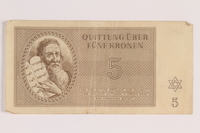
Theresienstadt ghetto-labor camp scrip, 5 kronen note, issued to a Dutch Jewish inmate
Object
Scrip, valued at 5 kronen, that may have been issued to Abigael de Vries in the Theresienstadt (Terezin) ghetto-labor camp in 1943. All currency was confiscated from deportees upon entry and replaced with scrip and ration coupons that could be exchanged only in the camp. Abigael was living in Amsterdam with her two children, 10 year old Hansje and 9 year old Ingeborg, when it was occupied by Germany in May 1940. The family was deported to Westerbork transit camp on May 26, 1943. In September, the children were released and sent to an orphanage in Amsterdam. Abigael was deported the next day to Bergen-Belsen concentration camp. On January 25, 1944, she was transferred to Theresienstadt and was there when the camp was liberated by Soviet troops on May 9, 1945. She was able to return to Amsterdam in July 1945. Her children were with her sisters who had taken custody of them from the orphanage in 1943. Hansje was paralyzed from the neck down, having been shot in the neck by a German soldier on April 23, 1945, while foraging for coal with his sister. Amsterdam had experienced severe food and fuel emergencies since the spring of 1945 so Abigael sent Inge to Copenhagen. Hansje died of his injuries on July 11, 1946.
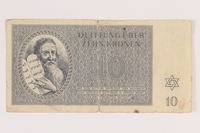
Theresienstadt ghetto-labor camp scrip, 10 kronen note, issued to a Dutch Jewish inmate
Object
Scrip, valued at 10 kronen, that may have been issued to Abigael de Vries in the Theresienstadt (Terezin) ghetto-labor camp in 1943. All currency was confiscated from deportees upon entry and replaced with scrip and ration coupons that could be exchanged only in the camp. Abigael was living in Amsterdam with her two children, 10 year old Hansje and 9 year old Ingeborg, when it was occupied by Germany in May 1940. The family was deported to Westerbork transit camp on May 26, 1943. In September, the children were released and sent to an orphanage in Amsterdam. Abigael was deported the next day to Bergen-Belsen concentration camp. On January 25, 1944, she was transferred to Theresienstadt and was there when the camp was liberated by Soviet troops on May 9, 1945. She was able to return to Amsterdam in July 1945. Her children were with her sisters who had taken custody of them from the orphanage in 1943. Hansje was paralyzed from the neck down, having been shot in the neck by a German soldier on April 23, 1945, while foraging for coal with his sister. Amsterdam had experienced severe food and fuel emergencies since the spring of 1945 so Abigael sent Inge to Copenhagen. Hansje died of his injuries on July 11, 1946.
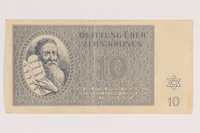
Theresienstadt ghetto-labor camp scrip, 10 kronen note, issued to a Dutch Jewish inmate
Object
Scrip, valued at 10 kronen, that may have been issued to Abigael de Vries in the Theresienstadt (Terezin) ghetto-labor camp in 1943. All currency was confiscated from deportees upon entry and replaced with scrip and ration coupons that could be exchanged only in the camp. Abigael was living in Amsterdam with her two children, 10 year old Hansje and 9 year old Ingeborg, when it was occupied by Germany in May 1940. The family was deported to Westerbork transit camp on May 26, 1943. In September, the children were released and sent to an orphanage in Amsterdam. Abigael was deported the next day to Bergen-Belsen concentration camp. On January 25, 1944, she was transferred to Theresienstadt and was there when the camp was liberated by Soviet troops on May 9, 1945. She was able to return to Amsterdam in July 1945. Her children were with her sisters who had taken custody of them from the orphanage in 1943. Hansje was paralyzed from the neck down, having been shot in the neck by a German soldier on April 23, 1945, while foraging for coal with his sister. Amsterdam had experienced severe food and fuel emergencies since the spring of 1945 so Abigael sent Inge to Copenhagen. Hansje died of his injuries on July 11, 1946.
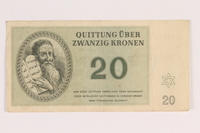
Theresienstadt ghetto-labor camp scrip, 20 kronen note, issued to a Dutch Jewish inmate
Object
Scrip, valued at 20 kronen, that may have been issued to Abigael de Vries in the Theresienstadt (Terezin) ghetto-labor camp in 1943. All currency was confiscated from deportees upon entry and replaced with scrip and ration coupons that could be exchanged only in the camp. Abigael was living in Amsterdam with her two children, 10 year old Hansje and 9 year old Ingeborg, when it was occupied by Germany in May 1940. The family was deported to Westerbork transit camp on May 26, 1943. In September, the children were released and sent to an orphanage in Amsterdam. Abigael was deported the next day to Bergen-Belsen concentration camp. On January 25, 1944, she was transferred to Theresienstadt and was there when the camp was liberated by Soviet troops on May 9, 1945. She was able to return to Amsterdam in July 1945. Her children were with her sisters who had taken custody of them from the orphanage in 1943. Hansje was paralyzed from the neck down, having been shot in the neck by a German soldier on April 23, 1945, while foraging for coal with his sister. Amsterdam had experienced severe food and fuel emergencies since the spring of 1945 so Abigael sent Inge to Copenhagen. Hansje died of his injuries on July 11, 1946.
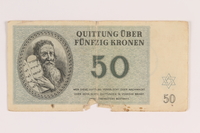
Theresienstadt ghetto-labor camp scrip, 50 kronen note, issued to a Dutch Jewish inmate
Object
Scrip, valued at 50 kronen, that may have been issued to Abigael de Vries in the Theresienstadt (Terezin) ghetto-labor camp in 1943. All currency was confiscated from deportees upon entry and replaced with scrip and ration coupons that could be exchanged only in the camp. Abigael was living in Amsterdam with her two children, 10 year old Hansje and 9 year old Ingeborg, when it was occupied by Germany in May 1940. The family was deported to Westerbork transit camp on May 26, 1943. In September, the children were released and sent to an orphanage in Amsterdam. Abigael was deported the next day to Bergen-Belsen concentration camp. On January 25, 1944, she was transferred to Theresienstadt and was there when the camp was liberated by Soviet troops on May 9, 1945. She was able to return to Amsterdam in July 1945. Her children were with her sisters who had taken custody of them from the orphanage in 1943. Hansje was paralyzed from the neck down, having been shot in the neck by a German soldier on April 23, 1945, while foraging for coal with his sister. Amsterdam had experienced severe food and fuel emergencies since the spring of 1945 so Abigael sent Inge to Copenhagen. Hansje died of his injuries on July 11, 1946.
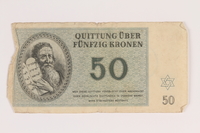
Theresienstadt ghetto-labor camp scrip, 50 kronen note, issued to a Dutch Jewish inmate
Object
Scrip, valued at 50 kronen, that may have been issued to Abigael de Vries in the Theresienstadt (Terezin) ghetto-labor camp in 1943. All currency was confiscated from deportees upon entry and replaced with scrip and ration coupons that could be exchanged only in the camp. Abigael was living in Amsterdam with her two children, 10 year old Hansje and 9 year old Ingeborg, when it was occupied by Germany in May 1940. The family was deported to Westerbork transit camp on May 26, 1943. In September, the children were released and sent to an orphanage in Amsterdam. Abigael was deported the next day to Bergen-Belsen concentration camp. On January 25, 1944, she was transferred to Theresienstadt and was there when the camp was liberated by Soviet troops on May 9, 1945. She was able to return to Amsterdam in July 1945. Her children were with her sisters who had taken custody of them from the orphanage in 1943. Hansje was paralyzed from the neck down, having been shot in the neck by a German soldier on April 23, 1945, while foraging for coal with his sister. Amsterdam had experienced severe food and fuel emergencies since the spring of 1945 so Abigael sent Inge to Copenhagen. Hansje died of his injuries on July 11, 1946.

Theresienstadt ghetto-labor camp scrip, 100 kronen note, issued to a Dutch Jewish inmate
Object
Scrip, valued at 100 kronen, that may have been issued to Abigael de Vries in the Theresienstadt (Terezin) ghetto-labor camp in 1943. All currency was confiscated from deportees upon entry and replaced with scrip and ration coupons that could be exchanged only in the camp. Abigael was living in Amsterdam with her two children, 10 year old Hansje and 9 year old Ingeborg, when it was occupied by Germany in May 1940. The family was deported to Westerbork transit camp on May 26, 1943. In September, the children were released and sent to an orphanage in Amsterdam. Abigael was deported the next day to Bergen-Belsen concentration camp. On January 25, 1944, she was transferred to Theresienstadt and was there when the camp was liberated by Soviet troops on May 9, 1945. She was able to return to Amsterdam in July 1945. Her children were with her sisters who had taken custody of them from the orphanage in 1943. Hansje was paralyzed from the neck down, having been shot in the neck by a German soldier on April 23, 1945, while foraging for coal with his sister. Amsterdam had experienced severe food and fuel emergencies since the spring of 1945 so Abigael sent Inge to Copenhagen. Hansje died of his injuries on July 11, 1946.
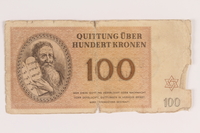
Theresienstadt ghetto-labor camp scrip, 100 kronen note, issued to a Dutch Jewish inmate
Object
Scrip, valued at 100 kronen, that may have been issued to Abigael de Vries in the Theresienstadt (Terezin) ghetto-labor camp in 1943. All currency was confiscated from deportees upon entry and replaced with scrip and ration coupons that could be exchanged only in the camp. Abigael was living in Amsterdam with her two children, 10 year old Hansje and 9 year old Ingeborg, when it was occupied by Germany in May 1940. The family was deported to Westerbork transit camp on May 26, 1943. In September, the children were released and sent to an orphanage in Amsterdam. Abigael was deported the next day to Bergen-Belsen concentration camp. On January 25, 1944, she was transferred to Theresienstadt and was there when the camp was liberated by Soviet troops on May 9, 1945. She was able to return to Amsterdam in July 1945. Her children were with her sisters who had taken custody of them from the orphanage in 1943. Hansje was paralyzed from the neck down, having been shot in the neck by a German soldier on April 23, 1945, while foraging for coal with his sister. Amsterdam had experienced severe food and fuel emergencies since the spring of 1945 so Abigael sent Inge to Copenhagen. Hansje died of his injuries on July 11, 1946.
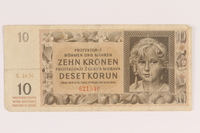
German occupation currency note, 10 kronen, issued in the Protectorate of Bohemia and Moravia
Object
Occupation currency note, valued at 20 kronen, issued in the Protectorate of Bohemia and Moravia in 1942. The Germans occupied these Czech provinces from 1939-1945, and created the Protectorate of Bohemia and Moravia as part of the Greater German Reich. The Czech garrison town of Theresienstadt (Terezin) was located within the Protectorate near the extended German border.
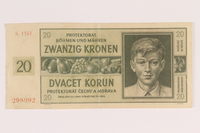
German occupation currency note, 20 kronen, issued in the Protectorate of Bohemia and Moravia
Object
Occupation currency note, valued at 20 kronen, issued in the Protectorate of Bohemia and Moravia in 1942. The Germans occupied these Czech provinces in 1939, and created the Protectorate of Bohemia and Moravia as part of the Greater German Reich. The Czech garrison town of Theresienstadt (Terezin) was located within the Protectorate near the extended German border.
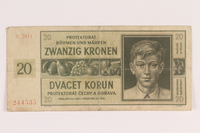
German occupation currency note, 20 kronen, issued in the Protectorate of Bohemia and Moravia
Object
Occupation currency note, valued at 20 kronen, issued in the Protectorate of Bohemia and Moravia in 1942. The Germans occupied these Czech provinces in 1939, and created the Protectorate of Bohemia and Moravia as part of the Greater German Reich. The Czech garrison town of Theresienstadt (Terezin) was located within the Protectorate near the extended German border.
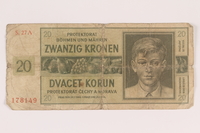
German occupation currency note, 20 kronen, issued in the Protectorate of Bohemia and Moravia
Object
Occupation currency note, valued at 20 kronen, issued in the Protectorate of Bohemia and Moravia in 1942. The Germans occupied these Czech provinces in 1939, and created the Protectorate of Bohemia and Moravia as part of the Greater German Reich. The Czech garrison town of Theresienstadt (Terezin) was located within the Protectorate near the extended German border.
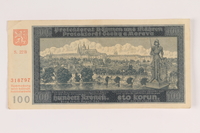
German occupation currency note, 100 kronen, issued in the Protectorate of Bohemia and Moravia
Object
Occupation currency note, valued at 100 kronen, issued in the Protectorate of Bohemia and Moravia in 1942. The Germans occupied these Czech provinces in 1939, and created the Protectorate of Bohemia and Moravia as part of the Greater German Reich. The Czech garrison town of Theresienstadt (Terezin) was located within the Protectorate near the extended German border.
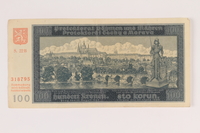
German occupation currency note, 100 kronen, issued in the Protectorate of Bohemia and Moravia
Object
Occupation currency note, valued at 100 kronen, issued in the Protectorate of Bohemia and Moravia in 1940. The Germans occupied these Czech provinces in 1939, and created the Protectorate of Bohemia and Moravia as part of the Greater German Reich. The Czech garrison town of Theresienstadt (Terezin) was located within the Protectorate near the extended German border.
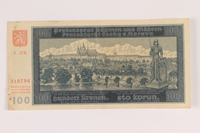
German occupation currency note, 100 kronen, issued in the Protectorate of Bohemia and Moravia
Object
Occupation currency note, valued at 100 kronen, issued in the Protectorate of Bohemia and Moravia in 1942. The Germans occupied these Czech provinces in 1939, and created the Protectorate of Bohemia and Moravia as part of the Greater German Reich. The Czech garrison town of Theresienstadt (Terezin) was located within the Protectorate near the extended German border.
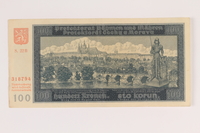
German occupation currency note, 100 kronen, issued in the Protectorate of Bohemia and Moravia
Object
Occupation currency note, valued at 100 kronen, issued in the Protectorate of Bohemia and Moravia in 1940. The Germans occupied these Czech provinces in 1939, and created the Protectorate of Bohemia and Moravia as part of the Greater German Reich. The Czech garrison town of Theresienstadt (Terezin) was located within the Protectorate near the extended German border.
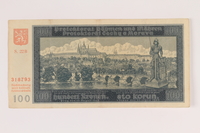
Protectorate of Bohemia and Moravia, 100 kronen note, issued in German occupied Czechosloavakia
Object
Occupation currency note, valued at 100 kronen, issued in the Protectorate of Bohemia and Moravia in 1940. Germany occupied these Czech provinces in March 1939, and created the Protectorate of Bohemia and Moravia as part of the Greater German Reich. The Czech garrison town of Theresienstadt (Terezin) was located within the Protectorate near the extended German border.
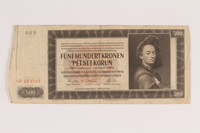
German occupation currency note, 500 kronen, issued in the Protectorate of Bohemia and Moravia
Object
Occupation currency note, valued at 500 kronen, issued in the Protectorate of Bohemia and Moravia in 1942. The Germans occupied these Czech provinces in 1939, and created the Protectorate of Bohemia and Moravia as part of the Greater German Reich. The Czech garrison town of Theresienstadt (Terezin) was located within the Protectorate near the extended German border.
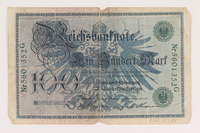
Imperial Germany Reichsbanknote, 100 marks, 100 marks, issued in 1908
Object
100 mark bank note issued in Imperial Germany in 1908. This note has a green seal which indicates it was printed post World War I (1914-1918.)
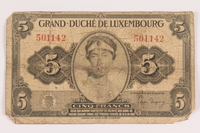
Luxembourg currency note, 5 francs, issued during the war
Object
5 franc bank note in use in 1944 in the Grand Duchy of Luxembourg.
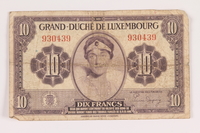
Luxembourg currency note, 10 francs, issued during the war
Object
10 franc bank note in use in 1944 in the Grand Duchy of Luxembourg.
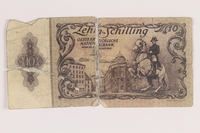
Austria paper currency note, 10 schillings, issued postwar
Object
10 schillings bank note issued by the Oesterreichische Nationalbank, Austria, in 1950.
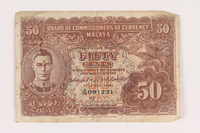
Straits Settlements and Malay States paper currency note, 50 cents, issued during World War II
Object
50 cents bank note issued in the Straits Settlements and Malay States in 1941. These settlements were colonies of Great Britain from 1867-1946. Beginning in 1939, the Malay dollar was recognized as leqal tender.
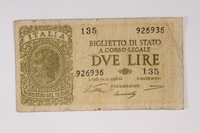
Italy currency note, 2 lire, issued by the Fascist government
Object
2 lire bank note issued in Italy from 1935-1944 when it was ruled by the Fascist government of Benito Mussolini.

Peru currency note, 5 soles de oro, issued postwar
Object
5 soles de oro bank note issued by the Banco Central de Reserva del Perú in Peru in 1956.

Brazil currency note, 100 cruzeiros, issued postwar
Object
100 cruzeiros bank note issued in Brazil.
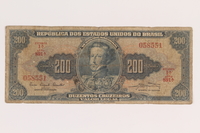
Brazil currency note, 200 cruzeiros, issued postwar.
Object
200 cruzeiros bank note issued in Brazil.
Diana Nikkels papers
Document
Collection of documents, memoirs, and photographs relating to Ingeborg De Vries [donor's mother] and Abigail De Vries [donor's grandmother] as well as their friends Simon Berklou and others who survived the Holocaust in Holland and Theresienstadt. The collection includes identification cards issued by the Jewish Council of Amsterdam, permits, and orders.
Star of David badge with Jood for Jew worn by a Dutch Jewish woman
Object
Star of David badge issued to Abigael de Vries in the Netherlands in 1942-1943. Abigael was living in Amsterdam with her two children, 10 year old Hansje and 9 year old Ingeborg, when it was occupied by Germany in May 1940. The family was deported to Westerbork transit camp on May 26, 1943. In September, the children were released and sent to an orphanage in Amsterdam. Abigael was deported the next day to Bergen-Belsen concentration camp. On January 25, 1944, she was transferred to Theresienstadt which was liberated by Soviet troops on May 9, 1945. She was able to return to Amsterdam in July 1945. Her children were with her sisters who had taken custody of them from the orphanage in 1943. Hansje was paralyzed from the neck down, having been shot in the neck by a German soldier on April 23, 1945, while foraging for coal with his sister. Amsterdam had experienced severe food and fuel emergencies since the spring of 1945 so Abigael sent Inge to Copenhagen for several months to regain her health. Hansje died of his injuries on July 11, 1946.

